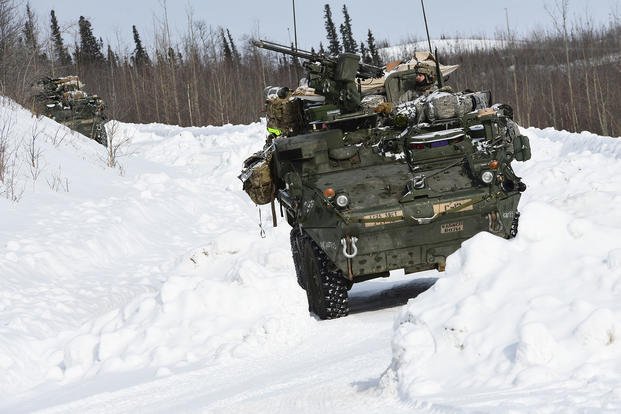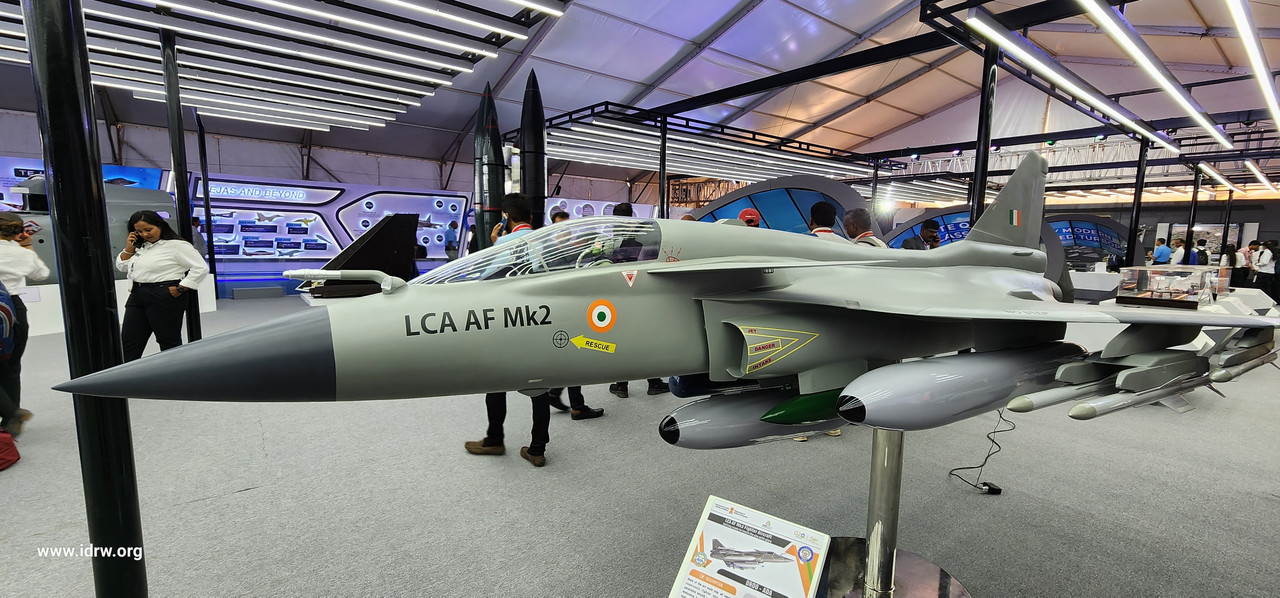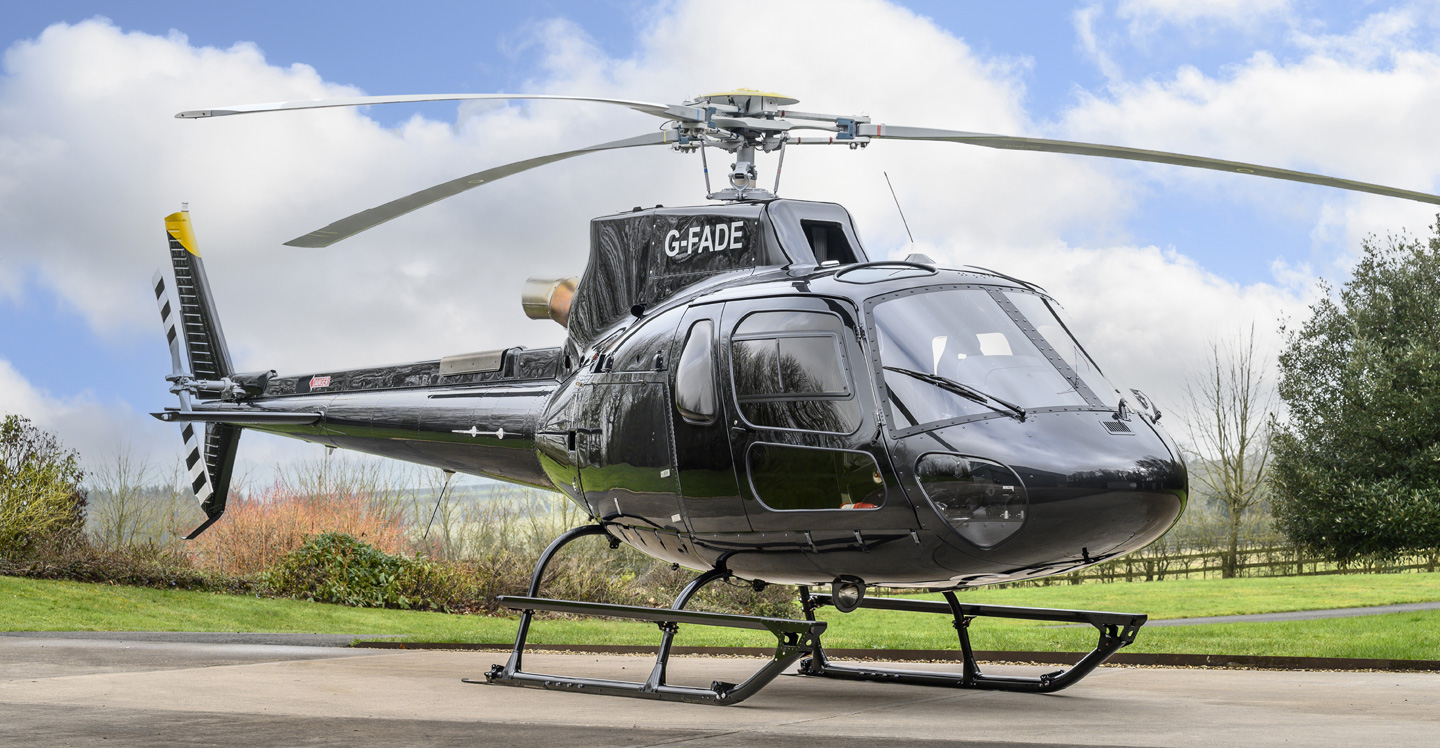Idrw Team
SOURCE: IDRW.ORG


India’s airborne early warning and control (AEW&C) capabilities are set to receive a significant boost with the upcoming Netra Mk1A and MkII programs. These advanced airborne warning and control systems (AWACS), developed under the aegis of the Defence Research and Development Organisation (DRDO), will incorporate state-of-the-art gallium nitride (GaN)-based transmit/receive modules (TRMs) in their active electronically scanned array (AESA) radar plates.
This marks a substantial technological leap over the existing Netra Mk1, which relies on solid-state gallium arsenide (GaAs)-based radar technology developed by the Electronics and Radar Development Establishment (LRDE) in Bengaluru. The transition to GaN-based systems promises enhanced performance, greater efficiency, and superior operational capabilities for the Indian Air Force (IAF).
Continue readingSOURCE: IDRW.ORG


Aero India 2025, held in Bengaluru from February 10-14, has solidified India’s trajectory toward redefining modern warfare, with the Indian Army unveiling a suite of cutting-edge unmanned aerial vehicles (UAVs) designed to target individual soldiers. This strategic pivot, showcased prominently at the airshow, signals a game-changing shift for infantry combat—particularly in the context of a potential conflict with Pakistan, which continues to prioritize larger, less agile UAV platforms. The innovations on display underscore India’s intent to dominate the tactical battlefield, leveraging precision, autonomy, and swarm technology to neutralize threats at the soldier level.
Pakistan’s UAV arsenal, bolstered by Chinese and Turkish collaborations, leans heavily on medium-altitude long-endurance (MALE) systems like the Wing Loong II, CH-4, and Bayraktar TB2—platforms optimized for surveillance, precision strikes on fixed targets, and broader operational scopes. While formidable, these larger drones lack the granularity to engage individual infantry effectively in dynamic, close-quarters scenarios. In contrast, the Indian Army’s focus at Aero India 2025 reveals a nuanced approach: small, agile, and lethal drones that promise to transform the infantry battlefield, especially along the volatile Line of Control (LoC).
Continue readingSOURCE: IDRW.ORG


Hyderabad-based VEM Technologies turned heads at Aero India 2025, held at Air Force Station Yelahanka in Bengaluru from February 10–14, with the debut of its Chaser loitering munition. Designed for Intelligence, Surveillance, Tracking, Attack, and Reconnaissance (ISTAR) missions, the Chaser combines advanced sensors, precision strike capabilities, and enhanced maneuverability into a single platform. Showcased as a versatile solution for modern warfare, this indigenous system reflects VEM’s growing stature in India’s defense ecosystem and its alignment with the Aatmanirbhar Bharat (Self-Reliant India) initiative.
The Chaser, displayed in a sleek canister launcher setup, promises to survey, detect, recognize, acquire, and strike a wide range of high-value targets—static or mobile—with minimal collateral damage. With export inquiries already trickling in, VEM Technologies is positioning the Chaser as a global contender in the rapidly expanding loitering munition market.
Continue readingSOURCE: IDRW.ORG


India’s push toward self-reliance in defense technology reached a new milestone at Aero India 2025, held in Bengaluru from February 10-14. NewSpace Research and Technologies, a Bengaluru-based aerospace startup, unveiled its Abhimanyu Collaborative Combat Aircraft (CCA)—a jet-powered unmanned aerial system (UAS) designed to operate alongside the Indian Navy’s MiG-29K fighters. Confirmed by the company during the exhibition, the Abhimanyu is engineered for carrier-based takeoff and landing, positioning it as a critical component of the Navy’s Naval Collaborative Combat Air Vehicle (N-CCAV) program. With this development, India is stepping boldly into the era of manned-unmanned teaming (MUM-T), enhancing its naval air power with a versatile and innovative platform.
Sporting a modest 4-meter (13-foot) wingspan, the Abhimanyu is notably smaller than many CCAs under development globally, such as the U.S.’s XQ-67A or Australia’s MQ-28 Ghost Bat. Yet, NewSpace sees this compact size as an advantage rather than a limitation. The company envisions the Abhimanyu as a stepping stone—a cost-effective, scalable solution that paves the way for more advanced platforms down the line. Its diminutive stature allows a carrier to deploy multiple units, offering tactical flexibility and the ability to overwhelm adversaries through sheer numbers.
Continue readingSOURCE: IDRW.ORG


India’s Twin Engine Deck-Based Fighter (TEDBF) program, a cornerstone of the Indian Navy’s future carrier-based aviation strategy, is progressing steadily despite swirling speculation about the Navy’s long-term pursuit of a full fifth-generation jet. An official from the Aeronautical Development Agency (ADA), speaking exclusively to idrw.org, confirmed that the Navy remains fully committed to the TEDBF, classified as a “5th Gen Minus” fighter.
This statement comes amid reports suggesting the Navy might pivot to a stealthier, fifth-generation platform under its Vision 2047 roadmap. Addressing these concerns, the ADA official emphasized that the program is on track, with the Preliminary Design Review (PDR) slated for completion later in 2025, and dismissed any plans to transform the TEDBF into a fully-fledged fifth-generation jet with features like an Internal Weapons Bay (IWB).
Continue readingSOURCE: IDRW.ORG


In a setback for the U.S.-backed Stryker Infantry Fighting Vehicle (IFV), reports have emerged of its underwhelming performance during high-altitude trials in Ladakh, conducted under the supervision of the Indian Army on behalf of General Dynamics Land Systems-Canada. While official details of the trials remain closely guarded, sources close to the Indian Army have shared revealing insights with idrw.org, painting a picture of significant operational challenges that could impact the Stryker’s prospects in India’s mechanized infantry modernization plans.
The trials, conducted in late 2024, have spotlighted the vehicle’s struggles in the rugged, oxygen-scarce terrain of Ladakh, contrasting sharply with the performance of India’s indigenous Wheeled Armoured Platform (WhAP) 8×8 in similar conditions.
Continue readingSOURCE: IDRW.ORG


India’s aerospace ambitions took a significant step forward with the development of the Hansa-NG (New Generation), an indigenous all-composite light aircraft designed by the Council of Scientific and Industrial Research-National Aerospace Laboratories (CSIR-NAL). Touted as India’s first aircraft in the CS-VLA (Certified Special Very Light Aircraft) category, the Hansa-NG is poised to revolutionize ab initio flight training, sports flying, and hobby aviation.
However, its journey hit a turbulence recently when the engine manufacturer, Rotax, hesitated to supply its advanced engines, citing potential military applications in UAVs or large drones. While this challenge has been successfully negotiated for now, it underscores the complexities of indigenous aerospace development in a globalized supply chain.
Continue readingSOURCE: IDRW.ORG


In a significant revelation, the Defence Research and Development Organisation (DRDO) has confirmed that its Long-Range Anti-Ship Missile (LRAShM), a hypersonic glide weapon tested in November 2024, achieved a speed of Mach 10—far exceeding the Mach 6-7 range speculated by many defence analysts post-trial.
The LRAShM, successfully flight-tested on November 16, 2024, from Dr. APJ Abdul Kalam Island off the coast of Odisha, was initially hailed as India’s first long-range hypersonic missile, with a reported range exceeding 1,500 kilometers. Developed indigenously by DRDO’s Dr. APJ Abdul Kalam Missile Complex in Hyderabad, in collaboration with other DRDO labs and industry partners, the missile combines the blistering speed of a ballistic missile with the maneuverability of a cruise missile. During the trial, tracked by multiple range systems across domains, the missile demonstrated terminal maneuvers and pinpoint accuracy, striking its target with devastating effect.
Continue readingSOURCE: IDRW.ORG


The Indian Air Force (IAF) is doubling down on its commitment to the Tejas MkII program, a cornerstone of India’s indigenous fighter jet ambitions, by advocating for a dedicated private sector-led production line. With the IAF funding 30% of the program’s estimated ?10,000 crore development cost, it is keen to accelerate the jet’s rollout and expand its fleet modernization plans.
Already committed to procuring 120 Tejas MkII jets to replace its ageing Mirage-2000 and MiG-29UPG aircraft starting in 2034-35, the IAF is now contemplating an upfront order for an additional 180 jets—potentially totaling 300 aircraft—if the Ministry of Defence (MoD) greenlights the private sector’s involvement. This bold move signals a transformative shift in India’s defense manufacturing ecosystem, blending public-private collaboration with strategic foresight.
Continue readingSOURCE: IDRW.ORG


In a significant step forward for India’s indigenous fighter jet development, the Government of India has approved the manufacturing of an assembly jig tailored for integrating a retractable in-flight refueling probe into the Light Combat Aircraft (LCA) Mk2, also known as the Medium Weight Fighter (MWF). This approval, announced in February 2025, paves the way for the detailed design and manufacturing of the assembly jig, specifically for the retractable Air-to-Air Refueling (AAR) probe module within the front fuselage of the LCA AF Mk2. Following this decision, the Aeronautical Development Agency (ADA) has initiated the procurement process, collaborating with the Aircraft Research and Design Centre (ARDC) of Hindustan Aeronautics Limited (HAL) to bring this critical component to life.
The assembly jig, a specialized fixture used to align and assemble complex aircraft components with precision, is pivotal for integrating the retractable AAR probe into the Mk2’s front fuselage. Unlike the fixed Cobham-supplied probes on earlier Tejas variants, the retractable telescopic probe—based on a Probe and Drogue system—reduces aerodynamic drag when not in use, improving fuel efficiency and stealth characteristics.
Continue readingSOURCE: IDRW.ORG


In a landmark move for India’s aerospace industry, the Tata Group and Airbus Helicopters have zeroed in on Bangalore as the likely location for their final assembly line (FAL) to produce H125 rotorcraft. Emerging as the frontrunner from a shortlist of five potential sites, Bangalore’s selection underscores its growing reputation as a hub for advanced manufacturing and aerospace innovation. This joint venture between Tata Advanced Systems Limited (TASL) and Airbus Helicopters marks India’s first private-sector helicopter assembly facility, aligning with the nation’s “Make in India” initiative and positioning the country as a key player in global rotorcraft production.
The Bangalore facility will serve as the nerve center for assembling the H125, a versatile single-engine helicopter renowned for its performance across civil and defense applications. Under the partnership, TASL and Airbus will handle the integration of all major components, including avionics, mission systems, electrical harnesses, hydraulic circuits, fuel systems, flight controls, and dynamic components. Powering the H125 will be the Safran Arriel 2D turboshaft engine, a proven workhorse that enhances the helicopter’s reliability and adaptability. The facility will also oversee testing, qualification, and delivery, ensuring that each aircraft meets stringent global standards.
Continue readingSOURCE: IDRW.ORG


In a striking display of India’s advancing defence capabilities, the Defence Research and Development Organisation (DRDO) showcased a full-scale model of the Hypersonic Glide Vehicle (HGV) under Project Dhvani at the ‘Vigyan Vaibhav’ defence exhibition held at Gachibowli Stadium, Hyderabad, from February 28 to March 2, 2025. This unveiling, inaugurated by Defence Minister Rajnath Singh, marks a significant milestone in India’s pursuit of cutting-edge hypersonic technology, positioning the nation among global leaders in this domain. Project Dhvani, with its innovative wave-rider design, promises to redefine efficiency and performance at hypersonic speeds, offering a glimpse into the future of India’s military arsenal.
Project Dhvani represents DRDO’s ambitious foray into developing Hypersonic Glide Vehicles capable of traveling at speeds exceeding Mach 5—approximately 6,200 km/h—while evading modern air defence systems. The full-scale model displayed at Gachibowli Stadium embodies the wave-rider configuration, a design that leverages the vehicle’s own shockwaves to minimize aerodynamic drag and enhance lift, ensuring superior performance in the hypersonic regime. This approach, rooted in advanced aerodynamics, allows the HGV to “ride” its shockwaves, reducing energy loss and enabling sustained high-speed flight.
Continue readingSOURCE: IDRW.ORG


India’s aerospace sector is buzzing with excitement, and at the heart of this momentum is DG Propulsion Private Limited (DPPL), a Delhi-based startup making waves with its indigenous jet engine technology. Prateek Dhawan, the company’s visionary Director, recently revealed ambitious plans to venture into the turbofan engine segment—a move that could redefine DPPL’s role in the global aviation landscape. Speaking about the company’s future, Dhawan emphasized that this leap hinges on securing investments within the next two to three years, a timeline that aligns with DPPL’s rapid rise following the success of its DG J40 jet engine.
DPPL has already carved a niche for itself with the DG J40, a micro-turbojet engine designed for unmanned aerial vehicles (UAVs) and defense applications. Boasting a thrust capacity of 40 kgf, the J40 has proven its mettle through rigorous testing, including a notable one-hour endurance run that exceeded expectations. This success has not only showcased India’s growing prowess in aerospace innovation but also put DPPL on the radar of investors, defense contractors, and industry watchers. Now, buoyed by this achievement, Dhawan sees an opportunity to take DPPL into the next frontier: turbofan engines.
Continue readingSOURCE: IDRW.ORG


The Defence Research and Development Organisation (DRDO) has sparked intrigue at the ‘Vigyan Vaibhav’ defence exhibition, held from February 28 to March 2, 2025, at Gachibowli Stadium in Hyderabad, by showcasing a mock-up of a previously unseen ballistic missile system labeled “BM-04.”
This debut, part of a sprawling display of India’s defense technologies, has left analysts and enthusiasts speculating about its role in the nation’s missile arsenal. Described by DRDO as a Short-Range Ballistic Missile (SRBM), the BM-04 appears to be designed to counter enemy anti-access/area denial (A2/AD) capabilities, incorporating a Common Hypersonic Glide Body (C-HGB) atop a two-stage booster—a configuration hinting at hypersonic ambitions. While the model is a dummy, its unveiling marks a tantalizing glimpse into DRDO’s evolving missile strategy.
Continue readingSOURCE: IDRW.ORG


Garden Reach Shipbuilders & Engineers (GRSE), one of India’s leading defense shipyards, has revealed that the Request for Proposal (RFP) for the P-17 Bravo project—a new class of stealth, guided-missile frigates—is expected to be issued by the end of 2025. This announcement signals the start of a highly anticipated procurement process that could reshape India’s naval capabilities and bolster the country’s domestic shipbuilding industry.
According to GRSE, the RFP will pave the way for the selection of L1 and L2 bidders by mid-2026. The L1 shipyard, deemed the lowest bidder, is poised to secure a massive order worth approximately Rs 40,000 crore, while the L2 shipyard, the second-lowest bidder, will receive an order valued at around Rs 30,000 crore. These contracts will cover the construction of the advanced warships, which are designed to enhance the Indian Navy’s operational strength with cutting-edge stealth and missile capabilities.
Continue reading